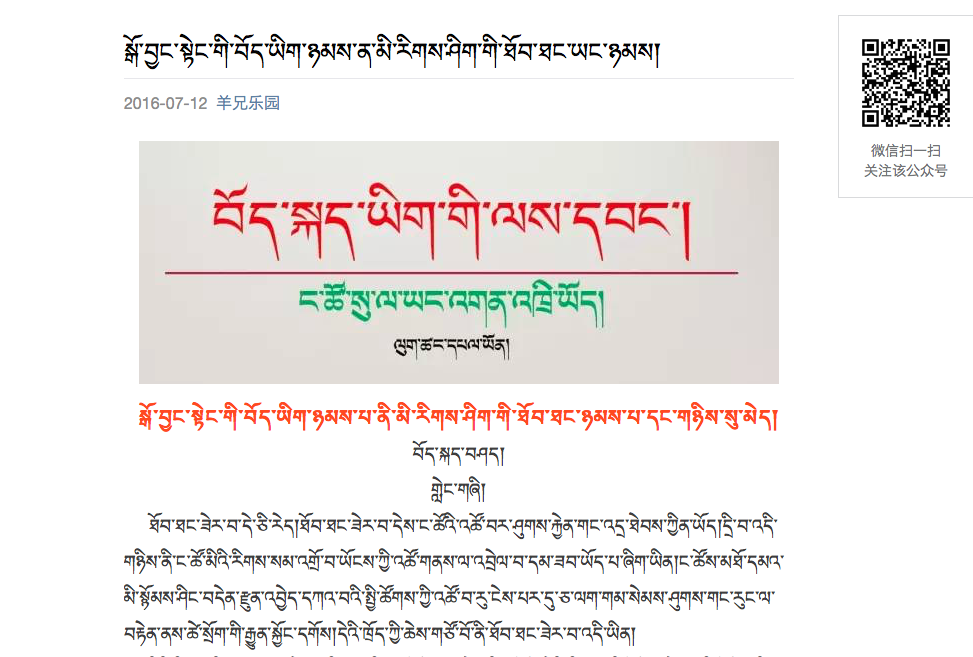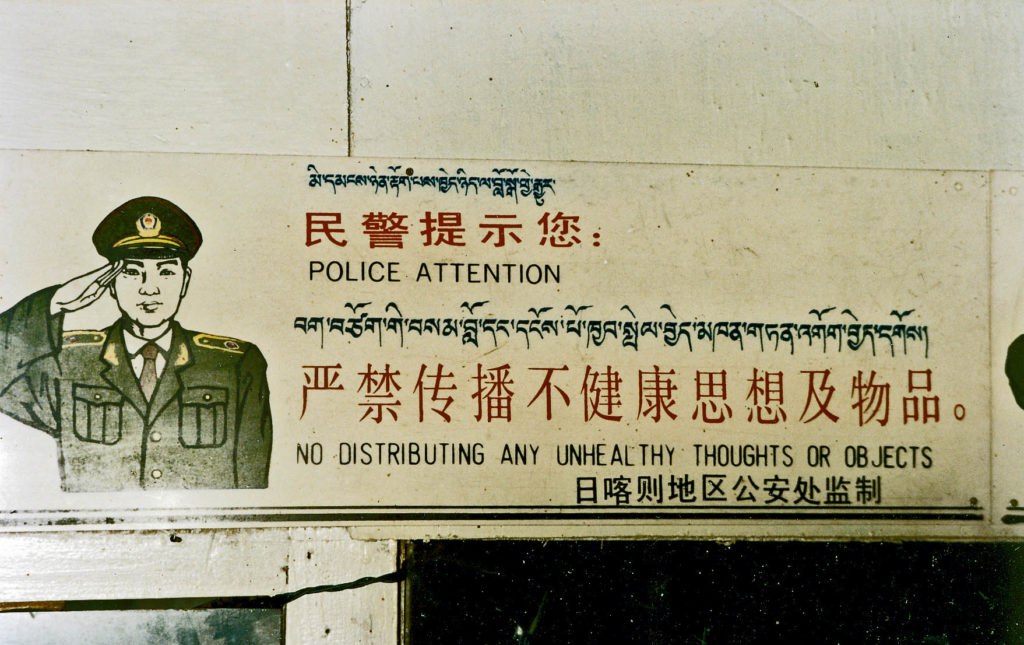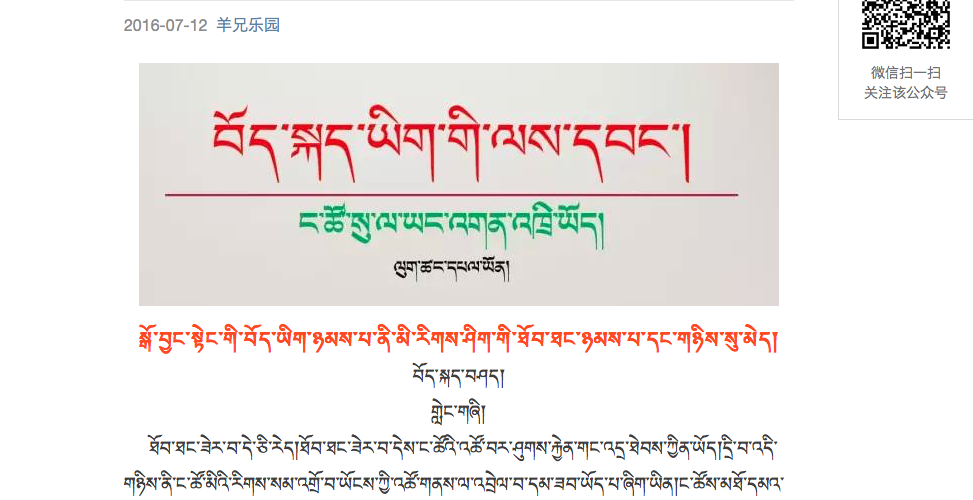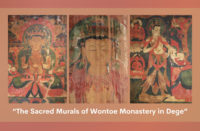High Peaks Pure Earth presents an English translation of an article originally published in Tibetan on the once popular website Tibet Sheep (Lugtsang Palyon) on December 7, 2016. The Tibet Sheep website that originated in 2013 is no longer live but translator Bhuchung D. Sonam gives us the following overview of what the Tibet Sheep website was:
Lugtsang Palyon (ལུག་ཚང་དཔལ་ཡོན་) is the name of a website. A layman nicknamed Lug Rinpoche (ལུག་རིན་པོ་ཆེ་) or “Precious Sheep” started this website at the beginning of 2013. The website uploads essays and articles on Tibetan culture, modern education etc daily. This was one of the first Tibetan websites and continues to this day with very good content.
For Tibetan netizens this is an important site since it provides content without leaning towards any particular religious school or specific region in Tibet. In the beginning this website focused on traditional Tibetan folk culture and Buddhist sciences. However, these days it also focuses on literature from around the world, education etc. It focuses on well-known Tibetan writers as well as on Tibetan medicine, general knowledge, Western civilisation, and contemporary Tibetan music etc.
The Tibet Sheep website may no longer be online but it now lives on as a WeChat channel doing the same as described above and continues its popularity.
The 2016 article below draws our attention to the status of Tibetan language as seen on signboards, shopfronts and road signs. Attention has always been paid to Tibetan language as a whole by Tibetans online as an important and pressing issue. Some of the points in the article below echo those made in 2014 by Khenpo Tsultrim Lodoe in his article “An Urgent Call for the Protection and Preservation of Tibetan Language”.
Thank you to Bhuchung D. Sonam for this translation and to those on Twitter who helped to crowdsource the photos used in the post as examples.

“The Standard of Tibetan Language on Signboards Indicates the Decline of our Basic Rights”
From Lugtsang Palyon
Introduction
What are rights? How do they impact our lives? These two questions have deep connections to the lives of our people and everyone around the world. In our lives in this land where there is inequality and difficulty in differentiating between right and wrong, we must continue to live either with the support of the material or with the strength of our mental attitudes. The most important thing amongst all other things are rights.
People live with each depending on the other in a society. Therefore, any community or a group must necessarily be included in this structure called society. Many conflicts inherently arise from this and greatly harm everyone’s survival. The most important thing in these relations among the communities is the thing called rights.
Rights are hence both powerful and dangerous. If they exist, then they are the foundation for life. If they die then it’s a precursor to a life being taken out of a body. Hence, it goes without saying that the moment one starts talking about rights it automatically leads to many obstacles. Everyone knows this.

A Case of Tibetan Language on Signboards Getting Weaker
When many nationalities live together, it leads to cases of each influencing the others’ progress and weakening. If one looks at this from all sides, both positive and negative influences depend on one’s ability for adjustments. However, if the other nationality comes to another’s native place and considers themselves as important, then gradually the native culture and way of life will be influenced by outsiders, and in the end, many scholars unanimously say that it will lead to the death of a nation though they may be some people from that nationality still alive.
It is appropriate to talk about whether the case of nationalities living in a mixed space is bad based on the changes taking place in real situations. If one talks about this issue based on unclear changes in reality, then there is the danger that readers may not be able to understand the issue. My survey may not be strong but I am going to talk in detail on some of the strong changes taking place. I hope that readers will be patient and read through this piece.
Tibet is like a huge bag stuffed with many crucial things or a solitary flower wrapped with poisonous thorns. Particularly in this twenty-first century when changes are taking place in pronounced ways, the fate of our people is becoming like the setting sun. Consequently, I want to touch on some of the dark critical issues on our path.
First and foremost, let’s begin with signboards above our doors which directly represents our rights. When I talk about rights, I generally feel its decline begins with changes on the outside. For example, two people may own a ten yuan note but if one of them forcefully stakes their claim on it and takes it, the other loses their rightful share of the cash. On the one side, this shows their character and on the other hand, it shows their inability to protect their own rights. Likewise, let’s take the example of Tibetans as one of the nationalities within the jurisdiction the Constitution of the People’s Republic of China. It may be within China, but it has its own unique culture, way of life and language, hence like other nationalities it has the responsibility to take control of the protection of its own rights.
Some people argue that the rights and ownership over the country should be proportionate to the size of population of each nationality. This is clearly a foolish idea. There are fifty-six nationalities in this country so while talking about overall development, one should not disregard the unique characteristics of each nationality. Many of the crucially important things happening in Tibetan regions may have to do with whether we have taken ownership over them.
Signboards are clear and easy examples. They can clearly tell us about many things. If one travels to many urban and rural areas in Tibet and gathers information just looking at signboards, it may be better than one hundred people going to a place and gathering information.
For example:
- Most of the signboards are in both Chinese and Tibetan
- The Chinese characters are bigger in size than the Tibetan letters
- The Chinese characters are written correctly while the Tibetan has many mistakes
- Crucially, important signs such as road signs, distance and directions are written only in Chinese
- Over eighty-five percent of the signboards written in Chinese have neon-lights or are featured with shiny electric lights
- Since there are no Tibetan signs on the roads, many Tibetans who are not literate in Chinese going for business end up asking for directions
- It appears that Chinese has the King’s position while the Tibetan language holds the status of a beggar
- In some offices, documents may be in Chinese and English but never in Tibetan
- If signboards get damaged, the Chinese signboards are immediately reinstalled while ones written in Tibetan remain unattended for a long time.
These are visible things that people can witness and accept. But how is it that people do not place any importance on this. While a small issue may be ignored like a drop of rain behind one’s ears, but large issues resembling a mountain being burst are also ignored. Why? How is it that all of us who travel up and down witness these but trample upon them?
I want to talk more about the above issues.
Firstly, this is an indication of how many positions all over Tibet are being held by Chinese. Signboards are a clear indication of which group of people are more in number in a region based in which these signs are written. Likewise, if we look at the signboards on shops then we can gauge that half the population in Tibet are Chinese. This case shows the situation of two or more nationalities existing in a region.
Secondly, this issue not only shows the existence of two nationalities in one region, but it even more clearly indicates that when the other nationality has the upper-hand, our situation worsens. It appears like a case of a font size, and yet deep down it signifies the superiority of one nationality over another. Frankly speaking, it means the owners are less important than the guests.
Thirdly, the issue denotes many more sad issues. For example, the fact that Chinese language signboards are repaired quickly means the Chinese voices are listened to and are more influential. Whereas Tibetan language signboards are not repaired for a long period, this shows that no one pays attention to them and that Tibetan voices are not important. It is similar to an orphan child being bullied more than a child with parents. It is natural that people don’t care and pay attention to something that is not important or is useless. Whether one pays attention to things (such as signboards) has a direct relation to one’s rights.
Fourth, here is an even clearer case. If the most important rights are lost to the other side, it is very common for people in urban and rural areas to live their lives just chasing small rights. If there is a competition among people to see which signs they can read/understand, there may be a few who are ignorant like the sun at night. But when it comes to actually taking responsibility to making amends, it is very rare. In the urban areas, it is taken that Chinese is the prevalent language and it doesn’t matter whether there is Tibetan or not. It has become a kind of a decoration. But it is not that in these areas there are no people who speak or read Tibetan. But it has become a habit to speak in Chinese and write in Chinese as a matter of convenience. These signs from people’s lives show that the use of Tibetan as a language is being discarded.
Fifth, because of the size of the population, they don’t give respect. If one is someone who loves one’s mother tongue, it is not difficult not to know about these issues. In one looks around in the daytime, it may appear that apart from signboards being in Tibetan, it may give an illusion that we have not lost our overall rights. But if one looks around in the dark of the night in a city, we will never see a signboard shining bright neon-lights written in Tibetan. This proves that it is a terrible outcome of our failure to take control of our awareness and rights. Everyone has paid scent attention to Tibetan language. Everyone has simultaneously discarded the use of Tibetan language in their lives. Everyone as if in mutual agreement has discarded the Tibetan language from Tibetan lands. By throwing something out of our doors, it is signalling others to throw the thing out too. Perhaps, this is the cry of an ownerless language that is dying. It may even be a cry of the both a thing and its owner ceasing to exist. In a nutshell, the fortune of Tibetan language in big and small towns and cities is diminishing.
Sixth, there is one issue we must fight for. Irrespective of whether which nationality has more population in Tibet or who owns it, whether one comes from outside or is native to this country, everyone must respect Tibetan people’s culture, way of life and language in order to coexist and live together. As it is common knowledge, villages and surrounding areas of districts are inhabited by Tibetans whereas within the district the Chinese people hold key positions and places. Therefore, Chinese people who cannot read Tibetan language and even some young Tibetans install signboards on their shops in Chinese language only. We must all know that this is a huge disrespect and a strong contempt to Tibetan language. A disparage to a culture is tantamount to disrespecting a people. It is high time for Tibetans to unite on this issue. If this is left unattended, then it is most likely that there won’t be any Tibetan written on the signboards.
Seventh, eighth and ninth can be clubbed together. Tibetan has become a secondary language. For a guest house, there may be two signboards, a big one and small one. A smaller one for the main door will have Tibetan on it in smaller font as compared to Chinese characters. The bigger signboard put on the walls of the guesthouse will have only Chinese and no Tibetan. In public places such as police stations, there is space for Tibetan language. Signs are written in Chinese and English. Never in Tibetan. This is truly strange. These offices may have a few foreigners coming for whom the signs are written whereas in our own land our own language is not used. Why? Is it because English is a global language and it is to move towards this direction? Whatever may be the consideration, it is absolutely not right for police stations, banks and other importance public offices to not have Tibetan language. If a signboard in Chinese is damaged, it is immediately repaired or replaced whereas a signboard in Tibetan when damaged remains like that for a long time.
In this way if I talk about issues regarding signboards, it is likely that over eighty percent of people will have feeling that they have heard about this issue in the past. What I write about is neither literature nor a treatise. Hence, this piece has no literary merit. This is an issue that one will hear about whether one bows their head down or whether one lifts their head up. I have no intention of providing deep knowledge to people. The reason I am writing about this is because I hope to gather people who can pay attention to and take responsibility on this issue.
If you discard this in spite of knowing about it, then it becomes just another matter. How should we decide on this issue … one must act on the knowledge on this and only then it becomes meaningful. Most of our people are not that smart … from our life-long experience we have learned i.e. our people have no aspiration to benefit others; our people have no sense of responsibility; our people have no pride in themselves; our people do not work hard; people have no sense of unity. They think it’s others business if a house goes burst; they think its other business if a mattress is pulled out from underneath; they think it’s someone’s business when a nearby wall falls down. In the end, they may even think that earning one’s livelihood is for the sake of others.
Our culture has not many facets and moreover it is not confrontational in nature. Because of this, others find many reasons to trample it under their feet. Therefore, we must and should reform our culture. The case of signboards is a mirror reflecting the real situation in our society. On appearance this may not look like much but in reality it is a beacon of light on our path.
Ways and Means to Improve the Standard of Tibetan Language on Signboards
When issues such this is made known to the general public, we must find ways to take decisions on these. In my opinion, these are some of the things we can do: 1. Reporting this to the local government; 2. Protests and public petition; 3. Our own initiatives.
- Reporting to the local government
The leaders these days keep on repeating that the local governments are there to fulfil people’s aspirations. If this is the case, the first thing we must do is to write appeal letters with signatures from the people and submit it to the local government. This has to be done over and again for a prolonged period of time to bear fruit.
- Protests and public petition
It is natural for any person to smile when happy and frown when feeling sad. It is natural too for people to struggle or try our best to gain back when someone takes away one’s belongings. Likewise, the Tibetan people must raise a voice of pain at a time when our language is facing life and death situation.
I am not inciting people to pick up arms to fight for Tibetan language. I am only asking people to use appeals/petitions to fight against this act to push Tibetan language to a lowly position. I appeal to people that through appeals and protest we have to demand the right for Tibetan language and to bring about real change.
- Our own initiatives
If we do not take care of our own possessions, it is rare for someone else take care of them. Even if someone does take care of our possessions, it is only a matter of shame. Therefore, we must remember how our parents taught us to take care of our own belongings when we were young. Hence in order to perform greater collective good, we begin with our own personal initiatives.
Each of us must begin with signboards on our own doors by writing them in correct and standard Tibetan language. We must give value and respect to our own language and use it in our daily lives. This is our collective responsibility that each of us must carry out without being asked. You, he, she and all of us aiming for greater collective Tibetan welfare must take care of our common possessions.
Endnote
Rights are not something one can beg and something that others can give to you. It is also not something that you can get with a help of NGO or funding agencies. It is something that one can obtain when one chases it. It is something that one can get if one fights for it.
Because we let go of our rights, our nationality is undergoing a low phase. Talking metaphorically, the issue of the signboards is tantamount to talking about our rights. Raising the issues concerning rights is the same as raising the concerns about our people. Without rights, we are ownerless beings. Without ownership will lead to the drying up of the essence of our lives and our path.
Many issues regarding a nationality hence must be raised through issues surrounding its language. Once these concerns are raised, we must follow a path to finding solutions to these. The important thing is to remember that we are often left lingering between raising the issue and finding solutions. When one thinks about it, some of our own people consider these heartfelt issues are confused talks, and some of our own people think these analyses as foolish chatter and give false explanations.
Even after a people have made a fundamental mistake in their outlook towards one’s values, they are still make amendments to it by achieving small victories. Therefore, all of us must assure that each finds an intellectual strategy to these issues concerning our nationality. This is a main responsibility of each Tibetan person.
Written on 9 September 2016, in Dartsedo.










Pingback: SECURITIZING TIBET – Rukor